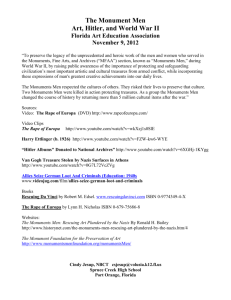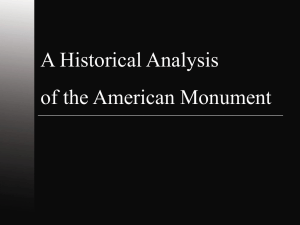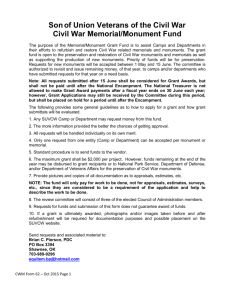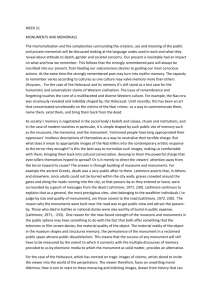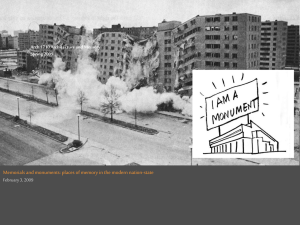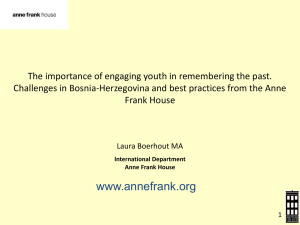PHOTOGRAMMETRIC SUPPORT FOR MONUMENT PROTECTION IN ARCHAEOLOGY by
advertisement
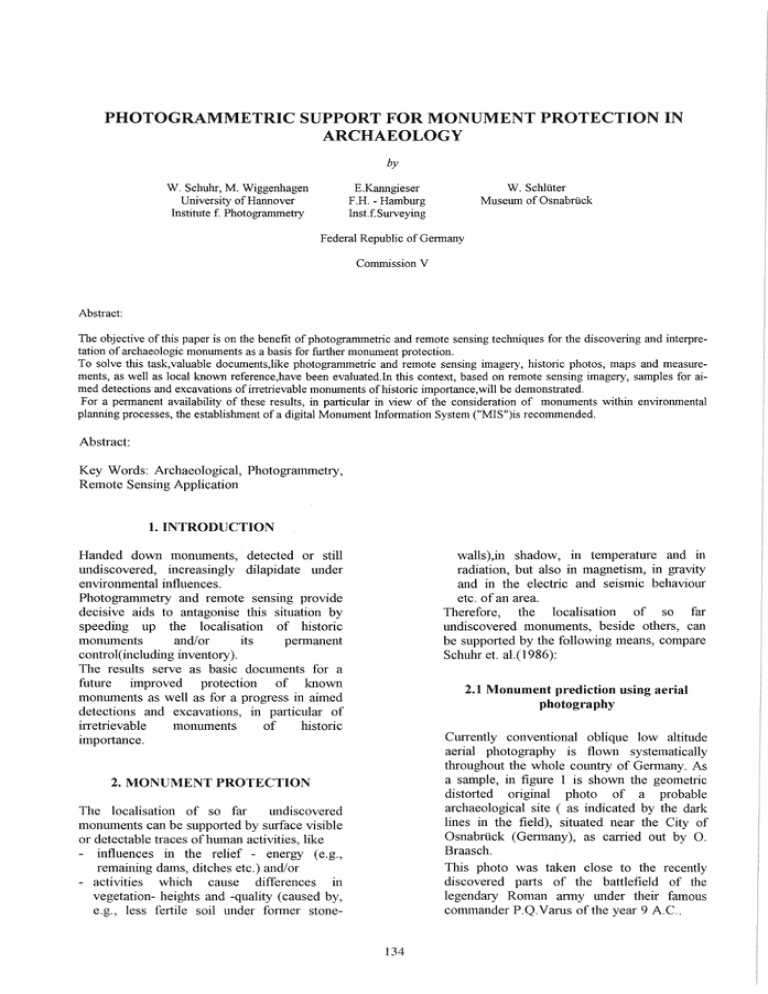
PHOTOGRAMMETRIC SUPPORT FOR MONUMENT PROTECTION IN ARCHAEOLOGY by VV. Schuhr,~. VViggenhagen University of Hannover Institute f. Photogrammetty VV. Schlüter of Osnabrück E.Kanngieser F.H. - Hamburg Inst. f. Surveying ~usemn Federal Republic of Gennany Commission V Abstract: The objective of this paper is on the benefit of photogrammetric and remote sensing techniques for the discovering and interpretation of archaeologic monmnents as a basis for further monmnent protection. T 0 solve this task, valuable docmnents,like photogrammetric and remote sensing imagery, historie photos, maps and measurements, as weH as Iocal known reference,have been evaluated.In this context, based on remote sensing imagery, sampies for aimed detections and excavations of irretrievable monuments ofhistoric importance,will be demonstrated. For a pennanent availability of these results, in particular in view of the consideration of monmnents within environmental planning processes, the establishment of a digital ~onmnent Infonnation System (ItMIS")is recommended. Abstract: Key Words: Arehaeologieal, Photogrammetry, Remote Sensing Applieation 1. INTRODUCTION walls),in shadow, in temperature and in radiation, but also in magnetism, in gravity and in the eleetrie and seismie behaviour ete. of an area. Therefore, the loealisation of so far lU1diseovered monuments, beside others, ean be supported by the following means, eompare Sehuhr et. al.(1986): Handed down monuments, deteeted or still undiseovered, inereasingly dilapidate under environmental influenees. Photogrammetry and remote sensing provide deeisive aids to antagonise this situation by speeding up the loealisation of historie andJor its permanent monuments eontrol(induding inventory). The resltlts serve as basic doeuments for a future improved proteetion of known monuments as weIl as for a progress in aimed deteetions and exeavations, in partieular of irretrievable monuments of historie importanee. 2.1 Monument prediction using aerial photography Currently eonventional oblique low altitude aerial photography is flown systematieally throughout the whole eountry of Germany. As a sampIe, in figure 1 is shown the geometrie distorted original photo of a probable arehaeologieal site ( as indieated by the dark lines in the field), situated near the City of OsnabfÜek (Germany), as earried out by O. Braaseh. This photo was taken dose to the reeently diseovered parts of the battlefield of the legendary Roman army under their famous eOlnmander P.Q.Vanls ofthe year 9 A.C .. 2. MONUMENT PROTECTION The loealisation of so far undiseovered monuments ean be supported by surfaee visible or deteetable traees of human aetivities, like - influenees in the relief - energy (e.g., remaining dams, ditehes ete.) andJor - aetivities whieh eause differenees in vegetation- heights and -quality (eaused by, e.g., less fertile soil under former stone- 134 In figure 2 is shown the eorresponding result of a digital geometrie image reetifieation, including the resampling of the digitised image of figure 1, see also Wester- Ebbinghaus (1986). As a final produet the edge enhaneed situation of the arehaeologieal texture, as already available in digital, easily ean be transforrned into existing maps or GIS (MIS) systems, see ehapter 4.2. This prograrn operationally runs on a Sun 5 Workstation and is in the stage of pe adaptation. In addition a low eost software version for the transformation of arehaeologieal texture into existing maps and / or GIS (MIS) data, based on veetor-data, exists at the Institute for Photogramrnetry of the University of Hannover. I Original oblIque photo of an archaeological site, taken by 0, Braasch ( 1991 ) Fig. 2: Digitally geometrie reetified oblique photo of an arehaeologieal site Fig. 3: Result of the edge enhaneement of a digitally reetified oblique photo, eontaining arehaeologieal textures 135 2.2 Monument prediction using remote sensing imagery appear, whieh must be taken into aeeount, as weIl as loeal ehanges in orientation. To indieate arehaeologieal sites in the field with some prob ability from this kind of distorted maps, aIl available historie maps of a probable arehaeologieal site are fitted piece wise with respeet to eaeh other and to reeent maps as well as to reetified aerial photographs, as far as available. Nowadays this fitting proeedure will be earried out digitaIly, based on digitised historie maps and / or photos. The digital veetorand/or raster-data interaetive is fitted to the up to date situation based on ground eontrol points and on texture infonnation. To image and to interpret the natural and artifieial eontrasts of the thennal radiation of the earth surfaee, an infrared line scanner or suited CCD -sensors are needed. In addition to this more operational remote sensing teehniques, the arehaeologieal and even the eart 0 graphie potential of radar imagery still is a matter of research. Not yet eompletely solved are the proper eonditions and the deepness of soil penetration of mierowaves. For dry terrain aradar penetration of about 40 m has been observed from grOlUld truth measurements. From spaee borne radar a ground penetration of about 10m is expeeted. On radar images of dry desert areas might appear aneient rivers, eurrently eovered by sand, whieh are not visible on eonventional photography. This ean lead to indieations for probable loeations of fonner settlements. 3. INTERPRETATION OF DISCOVERED MONUMENTS 3.1 Correlation of monuments with standard situations 2.3 Monument prediction using terrestrial photos As an example, the rectangular pattern of the monument diseovered in a field by aerial photography, as shown in figure 1, 2 and 3, with some probability might indieate the eharaeteristie shape of a Roman fortress, whieh has not been verified so far. As a sampie for a historie terrestrial photo, in figure 5 is shown the destroyed eastle of the City of Varel (Gennany) in the situation of dismantling. This photo is dated 1861 and was reeently diseovered in private property. It is the first photo graphie doeument of this monument ever reported on. So far only handed down paintings of this objeet existed. As a eontribution to monument predietion in eonjunetion with available historie maps of this building, this photo for instanee preeisely allows to reeonstruet main parts of this eastle and infonns about ensembles of ornaments, whieh now ean be searehed for, see ehapter 3.2. 3.2 Correlation of monuments with buildings or reconstructions In the following, as a typieal sampie, it is reported on the eorrelation of existing monuments with a historie photo of a building. This sampie already has been mentioned in ehapter 2.3. In this ease, further eorrelation of the monuments shown in Fig. 4 with a reeently diseovered historie photo of the portal of the destroyed eastle of the City of Varel (Gennany), dated 1861, see figure 5, with some probability identifies them as parts of the missing ornaments of the main portal of this eastle. Due to the existenee of these monuments, reeent reports on undeeorated faeades of this eastle, have to be ehanged. The introdueed ensemble eonsists of 4 monuments, including the figure of an angel. The remaining three stones show the so ealled rose of Aldenburg, for whieh the 5 petals are typieal, whieh still appear in the heraldie figure of that town. 2.4 Monument prediction using maps Historie maps and measurements often indieate geometrie inaeeuraeies and not suffieient identieal points. Therefore this type of maps, like mainly historie texts, might be only of qualitative rather than of quantitative value. In eases, where historie maps promise a sueeessful transfonnation of the situation of topographie details into the aetual situation, within the map loeal varying seales might 136 Fig. 4: Ornament ensemble of a lost portal as a candidate for monument correlation Fig. 5: Recently discovered photo, dated 1861, of a destroyed castle 3.3 Correlation of different objects Figure 6 shows a Roman coin of the year 7 BC., found in Adulia (Africa), showing a portrait of the legendary Roman centurion "P.QUINCTILI VAR!" ( same as mentioned in chapter 2.1 ),in comparison with the inscription of a silver casserole of the Hildesheim treasure, excavated in 1868, see Schuhr et.al.(1984). N otice the corresponding characteristic scripting of the sequence of the letters "TI" ("1" on top of the "T" in both cases(!)), as indicated by the arrow, which with high probability leads to the result, that between both objects might exist a relation. 137 Fig. 6: Correlation of a eoin legend with the inseription of a historie easserole 4. CONCLUSION 4.1 Monument protection For a permanent availability of these results and also in view of the eonsideration of the monuments within environmental planning proeesses, the establishment of an up to date Photogrammetry, remote sensing and eartography provide deeisive aids for the deteetion andlor inventory of irretrievable monuments of historie importanee, as a basis for further monument proteetion. Therefore historie maps, photos and measurements for this purpose in partieular, are very valuable, but handed down texts only with low priority. The reliability for the interpretation of the situation of so far undiseovered monuments only may be judged by exeavations or by substitutes for exeavations. System digital Monument Information ("MIS"), based on available GIS-Systems, like the ARC/Info, as already established in different eountries, is highly reeommended. 5. REFERENCES a)Sehuhr, W. ,Jaeobsen, K. ,Kmmgieser, E. and Biethahn, K, 1984: Analysis of a historie single photo.- In: Int. Areh. Photogramm. Remote Sensing, Rio, Brazil, Comm. V. 4.2 Monument Information System ( MIS) For a serious investigation of the reasons for the inereasing momunent dilapidation it is absolutely neeessary, to start with an inventory to doeument the reeent eonditions of the monuments. To judge on the sueeess of (e.g., ehemieal) measures for monument proteetion, a eontinuously repeating of the (photogralllffietrie) doeumentation of the eondition of the momunents shall be earried out in future. b)Sehuhr, W., 1986: Sampies for predietion support of arehaeologieal monuments. ISPRS Comm.V Symposium, presented paper, üttawa. e)Wester-Ebbinghaus, W. ,1986: Engineering Photogrammetry-Mathematieal aspeets and instrumental preeonditions. Presented paper, XVIII. International Congress, FIG, Toronto. 138

